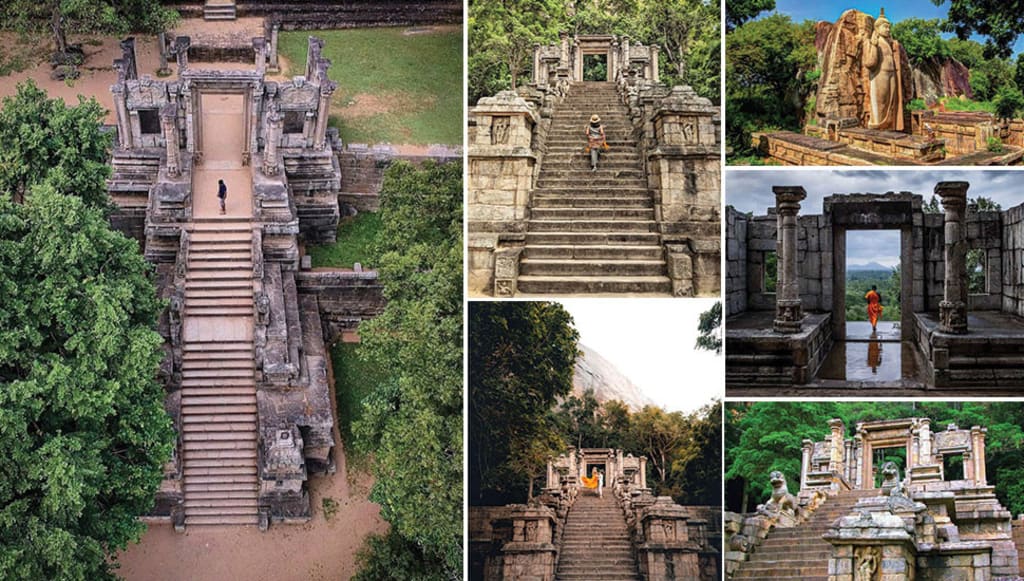Yapahuwa
The ancient kingdom In Sri Lanka

Yapahuwa can be introduced as one of the ruined cities in Sri Lanka. The famous Yapahuwa rock is located along the main road Kurunegala - Anuradhapura road, 46 kilometers north of Kurunegala city. The surrounding area was once the capital of our country for a brief period of time during the 13th century. Actually it was the 4th kingdom in this Land.
According to the historical sources, Yapahuwa was first occupied by the chief name Subha as a place defence against the South Indian forces who were penetrating southwards into the country. The rock is believed to have been named after Subha, Subha Pabbatha in Pali and Yapahuwa in Sinhala. Then, in 1272, Buwanekabhahu I had become the king and moved his capital from Polonnaruwa to Yapahuwa taking the Scared Tooth Relic along with him. It had been kept in a specially built structure at Yapahuwa. However, the Scared Relic was in Yapahuwa only for a short time. Soon after the death of the king in 1824, the Pandyans of South India had invaded the Island and also captured the Scared Relic.
Because of this tragic occurrence, the Sinhala Buddhists were thrown into total despair and the news spread over the Buddhist world. The Emperor in China, Kulbi Khar who had been a great friend of king Buwanekabhu, no sooner he heard this devastating news, sent am mission to India with an offer to exchange Tooth Relic for some fabulous treasure. It is recorded that before they could arrive in India, Parakramabhu III had become the king. Being aware of the fact that his legitimacy to the throne would be in question as long as the Sacred Relic was not in his possession, the king had gone in person to meet the Pandyans and negotiate for its return. The king's mission had been a success and he had returned with the Sacred Relic. Then, it had been enshrined once again in a specially constructed edifice in the new capital Kurunegala.
The walls of Yapahuwa from a rough semi-circle the ends of which join the foot of the high steeped rock. The outer area consists of an earthen rampart about 20 feet high and half a mile long.
The inner area consists of a stone wall around 12 feet in height. It is believed that the houses of common people would have been between the outer and inner walls, while king's palace, administrative buildings and the Temple of the Tooth were within the inner wall. The magnificent stairway structure goes upwards from the lower southern slopes of the rock to a natural terrace where the Temple of Tooth had once stood. The stairway had originally consisted of three flights of stone steps. These original steps are narrow and need to be manoeuvred sideways. According to historians, this may have been done as a form of defence as the steps can neither be ascended or descended hastily. It would certainly have paved the way for those at the top to arm themselves against any enemy onslaught.
At the top of the stairway, is a large stone doorway flanked by thick walls and two exquisitely carved windows. During early excavations, one window had been found in fragments, while the other, called "Seemadura Kavluwa" (perforated palace window) had been found in good condition.
There is a graceful female figure above which are two wide - eyed lions and elephants with their trunks extended. When passing the door, one can see the remains of the foundation of the temple. The rough path to the top of the rock is to the left. The caves at the top show that Yapahuwa was once inhabited by Buddhists monks.
There is a strong evidence that Yapahuwa had been a human settlement dating back from 1000 BC. These human settlements would have located in the area of six acres of flat land surrounding the rock. It is believed to be the earliest such settlement found in the location of a rock capital. This fortress capital of Sinhala kings, when abandoned had been taken over by Buddhists monks and religious ascetics.
It also certain that there had been a strong relationship between Yapahuwa and China during the short period it remained the capital of the island. Excavations carried out by the H. C. P. Bell at Yapahuwa have revealed Chinese ceramic ware and are considered among the finest ceramics found in the Island. In 1949, archaeological excavations carried out in this location unearthed 1310 Chinese coins dating back to the 13th century.
About the Creator
Dinetha jayasinghe
Blessed human life is the best gift we get in our entire life..!!
Enjoyed the story? Support the Creator.
Subscribe for free to receive all their stories in your feed. You could also pledge your support or give them a one-off tip, letting them know you appreciate their work.






Comments
There are no comments for this story
Be the first to respond and start the conversation.